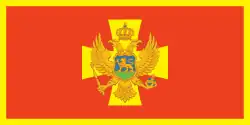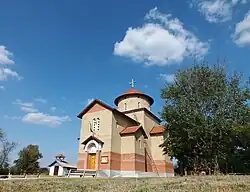Montenegrins of Serbia
Црногорци у Србији Crnogorci u Srbiji | |
|---|---|
 Flag of the National Council of the Montenegrin Ethnic Minority in Serbia | |
| Total population | |
| 20,238 (2022 census)[1] | |
| Regions with significant populations | |
| 12,424[2] | |
| 5,134[2] | |
| Languages | |
| Serbian, Montenegrin[3] | |
| Religion | |
| Eastern Orthodoxy (Serbian Orthodox Church) | |
| Related ethnic groups | |
| Serbs, South Slavs | |
Montenegrins are recognized ethnic minority in Serbia.[4] According to data from the 2022 census, the population of ethnic Montenegrins in Serbia is 20,238, constituting 0.3% of the total population.
However, these figures do not include the approximately two million people in Serbia who have partial or full ancestry from present-day Montenegro, mostly tracing back to the 18th and 19th centuries, vast majority of whom identify ethnically as Serb, though many (particularly first- or second-generation descendants from Montenegro) also claim a fairly strong Montenegrin regional identity.[5]
Demographics
The largest concentration of ethnic Montenegrins in Serbia are to be found in Vojvodina and Belgrade. There are 12,424 Montenegrins in Vojvodina or 0.7% of the provincial population. Montenegrin population is particularly present in municipalities of central Bačka: Mali Iđoš (12.3% of population), Vrbas (11.6%), and Kula (5.6%). Settlements with significant share of Montenegrins include: Lovćenac in Mali Iđoš municipality (37.3%), Kruščić (16%) in Kula municipality, as well as Savino Selo (17.9%) and Bačko Dobro Polje (12%) in Vrbas municipality.

| Part of a series on |
| Montenegrins |
|---|
 |
| By region or country |
| Recognized populations |
| Diaspora |
|
|
|
|
| Culture |
| Religion |
| Language and dialects |
| History |
|
History of Montenegro Rulers |
| Year | Population |
|---|---|
| 1948 | 74,860 |
| 1953 | 86,061 |
| 1961 | 104,753 |
| 1971 | 125,260 |
| 1981 | 147,466 |
| 1991 | 118,934 |
| 2002 (excl. Kosovo) | 69,049 |
| 2011 (excl. Kosovo) | 38,527 |
| 2022 (excl. Kosovo) | 20,238 |
Politics
The Montenegrin Party is the ethnic minority party representing interests of Montenegrins in Serbia.
Culture
Montenegrins in Serbia mostly speak Serbian, while some 10% declared Montenegrin as their mother tongue.[6] The Montenegrin language is one of languages in official use in the municipality of Mali Iđoš.[7]
The Association of Montenegrins of Serbia "Krstaš" is a cultural organization based in Lovćenac, dedicated to preserving and promoting Montenegrin cultural identity, language, traditions, and history among Montenegrins in Serbia, particularly in central Bačka, where there is a sizable Montenegrin community.
Notable people
- Mihailo Janketić, actor[8]
- Nenad Stevović, politician and publicist
- Adam Marušić, football player
See also
- Serbia–Montenegro relations
- Serbia and Montenegro
- Serbian–Montenegrin unionism
- Ethnic groups of Vojvodina
- Serbs of Montenegro
Sources
- ^ "Final results - Ethnicity". Почетна. 2023-07-14. Retrieved 2023-12-07.
- ^ a b "Population by ethnicity, by areas" (PDF). Retrieved 2023-12-07.
- ^ "Nacionalni savjet crnogorske nacionalne manjine".
- ^ https://minljmpdd.gov.rs/sektori/nacionalne-manjine/registar-nacionalnih-saveta-nacionalnih-manjina/
- ^ https://rtcg.me/vijesti/dijaspora/329779/i-dalje-pada-broj-crnogoraca-izmedju-popisa.html
- ^ https://popis2022.stat.gov.rs/en-US/5-vestisaopstenja/news-events/20230616-st/?a=0&s=0
- ^ B92: Crnogorski jezik u Malom Iđošu (Montenegrin language in Mali Iđoš) (in Serbian)
- ^ Serbia, RTS, Radio televizija Srbije, Radio Television of. "Miša Janketić – njegovi domovi bili su kuća i bina". www.rts.rs. Retrieved 2022-02-01.
{{cite web}}: CS1 maint: multiple names: authors list (link)